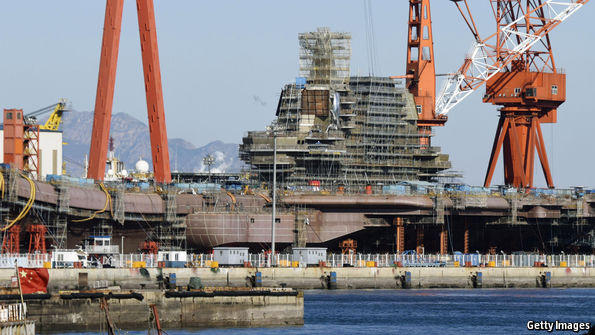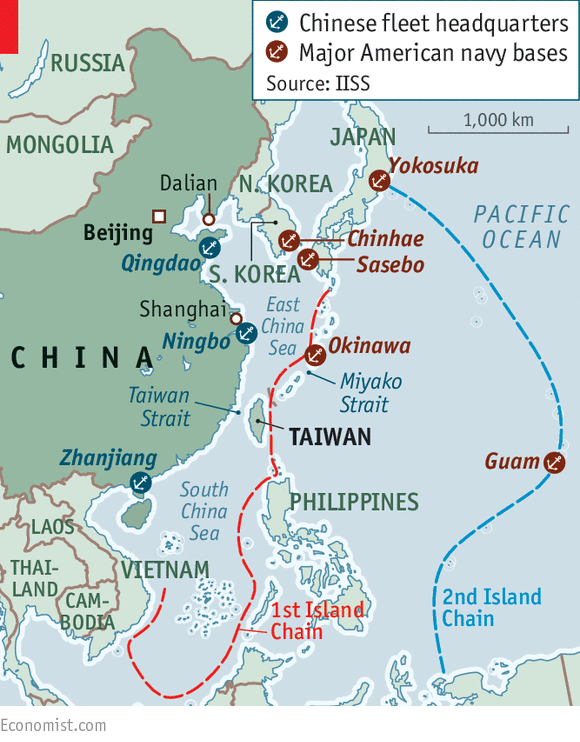From A Different Perspective:
China’s first aircraft-carrier bares its teeth
Should anyone be scared?
FOR Admiral Wu Shengli, the commander of China’s navy since 2006, it must have been a sweet swansong to mark his imminent retirement. In November China announced that its first and only aircraft-carrier, the
Liaoning, was combat ready. On December 24th its navy duly dispatched an impressive-looking carrier battle-group with three escorting destroyers, a couple of frigates, a corvette and a refuelling ship. It sailed from the northern port of Qingdao down through the Miyako Strait, past Taiwan and into the South China Sea.
Three weeks later the
Liaoning (pictured) was back in port having sailed home via the Taiwan Strait, thus completing a loop around the island. The point was not lost on the Taiwanese, who scrambled fighter jets and sent naval ships to monitor the group’s progress. The Chinese ships showed off their firepower, with Shenyang J-15 fighters staging a series of take-off and landing drills. That everything went smoothly was evidence of the navy’s transformation under Admiral Wu (his career perhaps destined by his forename, which means victory). He had meticulously prepared for this moment, which came just four years after the carrier, acquired as a partially built hulk from Ukraine in 1998, formally entered naval service.
China’s deployment of an aircraft-carrier is not a military game-changer. But it is a conspicuous symbol of the country’s ambitions as a maritime and global power. The
Liaoning has been a crucial building block for the navy in its evolution from a coastal defence force into what is now a modern navy that China uses to assert its (contested) maritime claims in the East and South China Seas. Within the next 25 years China expects its navy to become a powerful blue-water fleet that can guard China’s sea lanes of communication against any aggressor, push the US Navy beyond the “second island chain” far out into the Pacific (see map) and protect the country’s far-flung commercial interests.
Scary, perhaps, but also easy to sink
To that end, probably around 2004, China made up its mind that it must have aircraft-carriers. A second, indigenously designed one, based on the
Liaoning but with the latest radar and space for more aircraft, is nearing completion at the northern port of Dalian. Many analysts believe that a third such vessel, larger and more complex, is under construction in Shanghai. Andrew Erickson of the US Naval War College says Admiral Wu adopted a “crawl, walk, run” approach to developing a carrier capability, recognising the difficulties involved. Carrier operations are inherently dangerous—America lost 8,500 aircrew in the 40 years to 1988 on its way to reaching what Mr Erickson calls its current “gold standard” of carrier expertise.
Commissioning the
Liaoning was a good way to start. Much modified and fettled by the Chinese, the ship is based on the Soviet Kuznetsov-class design. It is big, with a displacement of about 60,000 tons, but nowhere near the size of America’s super-carriers such as the USS
Ronald Reagan, which is based in Japan. That Nimitz-class ship displaces around 100,000 tons.
In other ways, too, the
Liaoning pales in comparison with America’s 10 Nimitz-class carriers. They can carry more than 55 fixed-wing aircraft. The
Liaoning can only handle 24 J-15s (based on the Russian Sukhoi SU-33) and a handful of helicopters. Unlike the American carriers, itlacks a catapult to propel aircraft from its deck. Instead it relies on a “ski-jump” prow to provide extra lift. As a result, the J-15s have to carry a lighter load of weapons and fuel. Heavier, slower airborne early-warning and anti-submarine aircraft cannot take off from the
Liaoning at all. That limits the type of missions the ship can perform and makes the vessel vulnerable when operating beyond the range of shore-based aircraft. The
Liaoning also depends on a notoriously unreliable Soviet-era design for its steam turbines, which cuts its range and speed compared with the nuclear-powered Nimitz-class carriers.
The US Office of Naval Intelligence has dismissed the
Liaoning’s ability to project naval power over a long distance. But the ship does have military value. It can provide air-protection for China’s fleet, and would be a major asset in disaster-relief or evacuation missions. Peter Singer of the New America Foundation, a think-tank, says that a
Liaoning-led battle group would also seem pretty formidable to neighbours, such as Vietnam or the Philippines, should China feel like bullying them.
But the main value of the
Liaoning is the experience that it is giving the navy in the complex choreography of carrier operations. Those skills will help in the eventual deployment of indigenously designed carriers. The Chinese have been training with catapult-launch systems on land. This has fuelled speculation that the carrier thought to be under construction in Shanghai will be a genuine flat-top. It is possible that the ship will also be nuclear-powered, which could give it the range and speed of American carriers.
It is not clear how many carriers China plans to build. As a rule of thumb, you need three to be certain of having one at sea all the time. Mr Erickson says that some analysts in China have been suggesting a fleet as large as six. Mr Singer thinks it is possible that China’s carriers will one day match the capability of American ones. Mr Erickson says that while China can copy a lot, without combat experience and “tribal knowledge” passed from one crew to another, it will find it hard to attain that level.
China, ironically, has done more than any other country to sow doubts about whether carriers are worth all the effort and expense, by developing shore-based anti-ship ballistic missiles, such as the DF-21D and DF-26, known as “carrier killers”. Submarines are less vulnerable, but highly visible ships bristling with weaponry are still badges of pride for aspiring great powers like China. As in America, the view in China that carriers and status go together will be hard to change.



